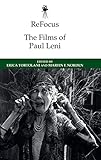ReFocus : The Films of Paul Leni / Martin F. Norden, Erica Tortolani.
Material type: TextSeries: ReFocus: The International Directors Series : RFIDSPublisher: Edinburgh : Edinburgh University Press, [2022]Copyright date: ©2021Description: 1 online resource (288 p.) : 26 B/W illustrationsContent type:
TextSeries: ReFocus: The International Directors Series : RFIDSPublisher: Edinburgh : Edinburgh University Press, [2022]Copyright date: ©2021Description: 1 online resource (288 p.) : 26 B/W illustrationsContent type: - 9781474454513
- 9781474454537
- 791.430232092
- online - DeGruyter
| Item type | Current library | Call number | URL | Status | Notes | Barcode | |
|---|---|---|---|---|---|---|---|
 eBook
eBook
|
Biblioteca "Angelicum" Pont. Univ. S.Tommaso d'Aquino Nuvola online | online - DeGruyter (Browse shelf(Opens below)) | Online access | Not for loan (Accesso limitato) | Accesso per gli utenti autorizzati / Access for authorized users | (dgr)9781474454537 |
Frontmatter -- Contents -- List of Figures -- Notes on Contributors -- Chronology -- 1 Introduction -- 2 Exploding the Cosmopolitan and Treating the Foreigners’ Foreignness: Paul Leni’s The Diary of Dr. Hart -- 3 The Unnatural in the Natural: Leopold Jessner and Paul Leni’s Early Weimar Film Backstairs -- 4 Cinema Panopticum: Wax, Work, Waxworks -- 5 The Proto-Horror-Comedy: Waxworks -- 6 Intersectional Avant-Garde: Paul Leni’s Rebus-Film Series and the Confluence of Experimental Visual Styles -- 7 Bravura Beginnings: Paul Leni and the Art of the Prologue -- 8 Paul Leni’s The Cat and the Canary: Adaptation into Genre -- 9 Specters of the Mind: Ghosts, Illusion, and Exposure in Paul Leni’s The Cat and the Canary -- 10 Misfitting in America: Paul Leni, Conrad Veidt, and The Man Who Laughs -- 11 Masculinity and Facial Disfigurement in The Man Who Laughs -- 12 Cinematic Space and Set Design in Paul Leni’s The Last Warning -- 13 The Last Warning: Uncertainty, Exploitation, and Horror -- Filmography -- Index
restricted access online access with authorization star
http://purl.org/coar/access_right/c_16ec
Offers the first comprehensive English-language book on the life and career of Paul LeniCovers many dimensions of Leni's professional creativity, including his early visual and theatrical work in Germany during the 1910s, collaborations with contemporary filmmakers, career in and experiments with set and stage design, and transition from German to Hollywood filmmakingEngages with new historical, analytical, and theoretical perspectives on Leni's most influential filmsSilent-era film scholarship has all too often focused on a handful of German directors, including Fritz Lang, F. W. Murnau and Ernst Lubitsch, but little attention has been paid to arguably one of the most influential filmmakers of the period: Paul Leni. This collection – the first comprehensive English-language study of Leni’s life and career – offers new insights into his national and international films, his bold forays into scenic design and his transition from German to Hollywood filmmaking.The contributors give fresh insights into Leni’s most influential films, including Waxworks (1924), The Cat and the Canary (1927) and The Man Who Laughs (1928), and explores such lesser-known productions as The Diary of Dr. Hart (1918), Backstairs (1921) and the Rebus film series (1925–7). Engaging with new historical, analytical, and theoretical perspectives on Leni’s work, this book is a groundbreaking exploration of a cinematic pioneer.
Mode of access: Internet via World Wide Web.
In English.
Description based on online resource; title from PDF title page (publisher's Web site, viewed 01. Dez 2022)


